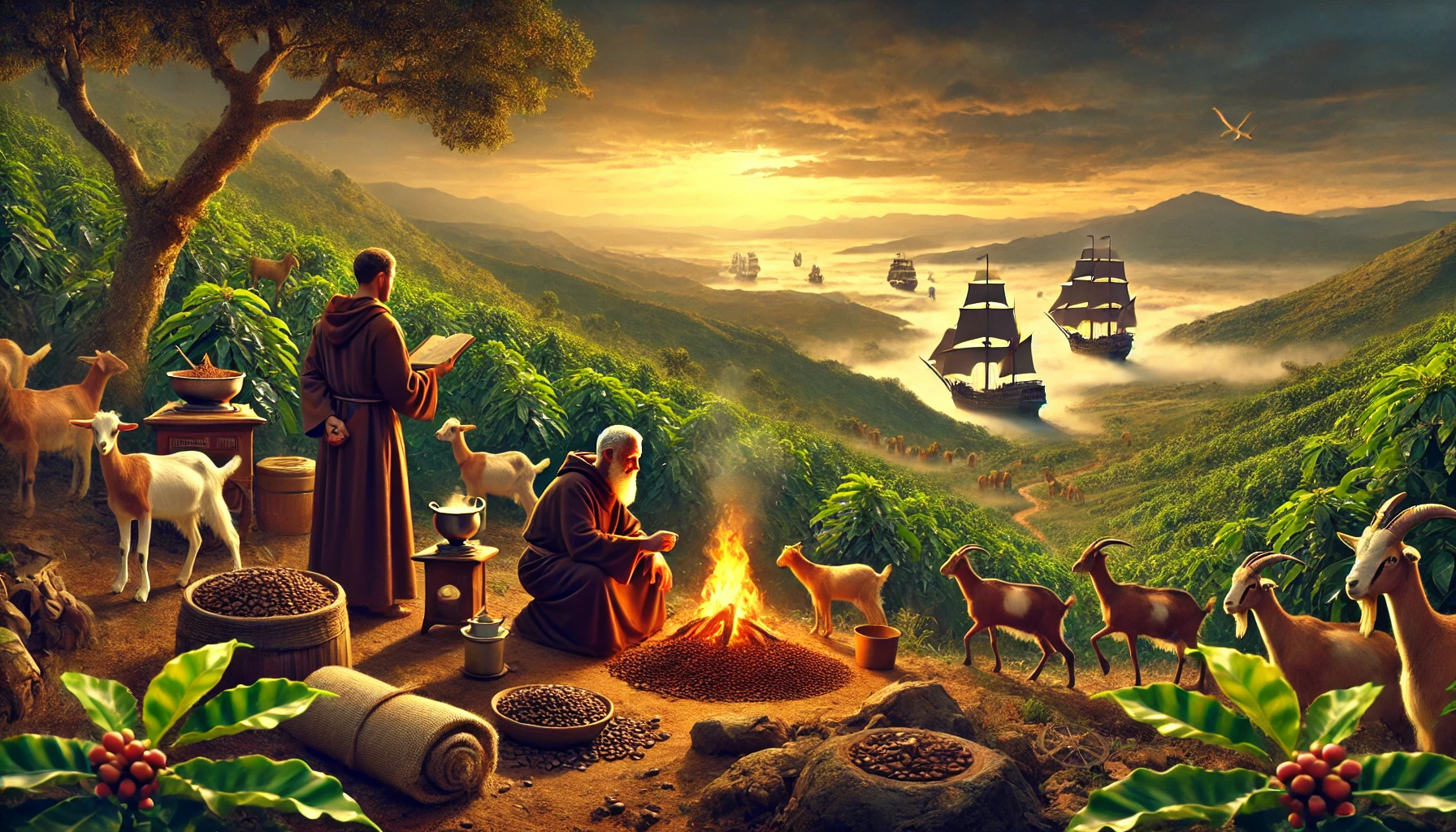Coffee is more than a beverage—it’s a cultural phenomenon with centuries of history behind each cup. From mystical legends in the Ethiopian highlands to becoming the world’s most consumed beverage after water, coffee’s journey is steeped in tradition, migration, and transformation. In this article, we’ll dive into the fascinating origin story of coffee, tracing how it evolved into the global staple it is today.
The Ethiopian Legend: Kaldi and the Dancing Goats
The earliest known story of coffee’s discovery dates back to the 9th century in the region of Kaffa, located in modern-day Ethiopia. According to legend, a young goatherd named Kaldi noticed that his goats became unusually energetic after eating red berries from a certain shrub. Intrigued, Kaldi tried the berries himself and felt a similar burst of vitality.
He brought the fruit to a local monk, who disapproved of its stimulating effect and threw it into the fire. But as the berries roasted, they released an enticing aroma. The roasted beans were raked from the embers, ground up, and dissolved in hot water—allegedly creating the first cup of coffee.
Though this tale is likely apocryphal, it reflects the ancient roots of coffee in East African oral history and provides a colorful introduction to the beverage’s deep cultural roots.
Coffee’s First Cultivation: Yemen and the Sufi Mystics
While Ethiopia is widely accepted as coffee’s birthplace, Yemen played a crucial role in transforming it into a cultivated crop and a spiritual tool. By the 15th century, coffee cultivation and trade had taken root in the Yemeni port city of Mocha. Here, Sufi mystics used coffee to stay awake during long nights of dhikr (spiritual chanting and prayer). They referred to coffee as “qahwa,” which originally meant wine in Arabic—a reference to its ability to uplift the soul.
Coffeehouses, known as qahveh khaneh, began appearing throughout Yemen and the surrounding Islamic world. These were places of gathering, music, conversation, and intellectual exchange, laying the foundation for coffee’s social significance.
The Spread of Coffee Through the Islamic World
From Yemen, coffee spread to Mecca, Medina, and Cairo. The beverage became central to Islamic culture, both religious and social. Coffeehouses grew in popularity, often becoming sites of political discussion and intellectual debate.
Despite occasional bans by conservative religious authorities—who feared coffee’s stimulating effects and the influence of lively coffeehouse gatherings—coffee’s popularity surged. Traders carried it throughout the Ottoman Empire, North Africa, and eventually into Europe.
Entering Europe: From Curiosity to Commodity
Coffee arrived in Europe in the 17th century, first through Venetian traders who had contact with the Ottoman Empire. Initially met with suspicion, it was dubbed the “bitter invention of Satan” by some clergy. But in 1600, Pope Clement VIII allegedly tasted coffee and gave it his blessing, helping to eliminate its stigma among Christians.
Coffeehouses began to emerge in major cities like Venice, Paris, and London, quickly becoming hubs for commerce, communication, and community. Known as “penny universities” in England, coffeehouses charged a penny for a cup and access to stimulating conversation and news.
This period also saw the beginning of European colonial powers cultivating coffee abroad—France in the Caribbean, the Dutch in Java, and later the Portuguese in Brazil.
The Dutch and the Global Coffee Trade
The Dutch played a pivotal role in transforming coffee from a regional drink into a global commodity. By the 17th century, the Dutch East India Company had secured coffee plants from Yemen and started cultivating them in their colonies, especially on the island of Java (now Indonesia). This is why “Java” is still a slang term for coffee.
They created vast coffee plantations using enslaved labor, establishing the first major global supply chains for the product. This era marked coffee’s transition from a mystical beverage to a profitable commodity controlled by colonial powers.
Coffee in the Americas: Brazil and Beyond
Coffee arrived in the Americas in the early 18th century, brought by French and Portuguese colonists. Brazil became a dominant force in coffee production by the 19th century, thanks to its favorable climate, massive plantations, and labor force (initially enslaved people, and later immigrant workers).
Today, Brazil remains the largest coffee producer in the world, a legacy that dates back centuries. The Americas also introduced new variations in brewing, roasting, and serving coffee, influencing modern coffee culture globally.
The Evolution of Coffee Culture
Coffee is not just a drink—it has served as a symbol of rebellion, refinement, and relaxation throughout its history. Whether in Ottoman coffeehouses, Parisian cafés, or Seattle espresso bars, the act of drinking coffee has always been tied to culture, identity, and community.
Over time, coffee became a staple of daily routines, a tool of productivity, and a ritual of comfort. As new brewing methods developed—like espresso in Italy, pour-over in Japan, or cold brew in the U.S.—coffee’s versatility and cultural reach continued to expand.
A Symbol in Art, Literature, and Politics
From French philosophers debating in cafes to political revolutions planned over cups of coffee, this beverage has long played a role in shaping society. In literature, coffee appears as a symbol of intellect, introspection, or social interaction. Painters like Édouard Manet and writers like Honoré de Balzac immortalized café culture in their works.
Coffee has also been at the center of political and economic transformations. The Boston Tea Party, for example, led many Americans to switch from tea to coffee as a patriotic statement.
A Drink for the World
Today, over 2.25 billion cups of coffee are consumed every day worldwide. From street-side espresso shots in Italy to elaborate coffee ceremonies in Ethiopia, the world’s relationship with coffee remains as diverse as its history.
Modern coffee culture embraces sustainability, fair trade, and artisanal brewing. Yet, each cup still carries echoes of its rich and winding past—a journey from a goat-herder’s discovery to a global tradition.
Why the Origins of Coffee Matter Today
Understanding the origins of coffee allows us to appreciate its depth beyond flavor. Each region’s adaptation of coffee reflects its values, struggles, and creativity. In a world where coffee is often consumed mindlessly, taking a moment to consider its journey makes the experience richer, more human.
Whether you’re a barista, a historian, or a casual drinker, the story of coffee is, in many ways, the story of us.

